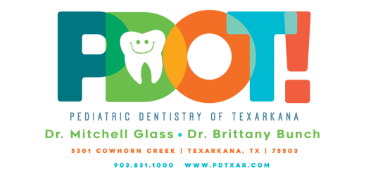Preventative care
Cleanings & Exams
Prevention is the key to good dental health. Cleanings every six months and oral evaluations are the best way to ensure healthy teeth. Our team provides thorough, individualized care for each child, creating specific treatment plans and educating both kids and parents on good dental habits.
Fluoride
Fluoride varnish is a dental treatment that can help prevent tooth decay. The varnish is made with fluoride, a mineral that can strengthen tooth enamel (outer coating on teeth). Fluoride varnish is “painted” on the top and sides of the teeth with a small brush. It does not hurt when the varnish is applied. The varnish is sticky, but hardens once it comes in contact with saliva. Patients can eat and drink right after the fluoride varnish is applied, but should avoid hot foods, liquids, and sticky candy.
X-Rays
Diagnosing dental conditions is safe and easy thanks to digital radiography, known as digital x-ray. The digital x-ray system allows us to capture x-ray images that are then easily stored directly to a computer. Digital x-rays reduce patient radiation exposure by up to 90 percent compared to the already low exposure of traditional dental x-rays. As a preventative diagnostic tool, dental x-rays are essential, revealing valuable information not otherwise visible during a regular dental exam. They enable the dentist to look between teeth and under the gum, then use this information to safely and accurately detect hidden dental abnormalities and create an accurate treatment plan. Without x-rays, problem areas may go undetected.
Well-Baby Exams
Learning proper oral hygiene habits early can help lead to a lifetime of good dental health. The American Dental Association and the American Academy of Pediatric Dentistry recommend babies have their first dental visit within six months after their first tooth appears, but no later than the child’s first birthday. During the well-baby visit, the dentist will examine the child’s teeth and gums for any problems, explain the best way to clean their teeth, discuss diet and fluoride needs, and recommend oral care products. The dentist can answer any questions, just like a well-baby visit with a pediatrician. Baby teeth are critical in the development of adult teeth, and seeing a pediatric dentist helps to develop a healthy habit for routine and preventative care.
Space Maintainers
A space maintainer is a custom made appliance with the purpose of holding space for a permanent tooth to erupt and come into place. Baby teeth are important to the development of the teeth, jaw bones, and muscles and help to guide the permanent teeth into position when the baby teeth are lost. If a baby tooth is lost or extracted early, the space maintainer can hold the space open until the permanent tooth erupts.
Sealants
A dental sealant is a thin, tooth-colored coating painted on the chewing surface of the tooth (usually premolars and molars) to help prevent tooth decay. This effectively “seals” the deep grooves, acting as a barrier and protecting enamel from bacteria, plaque, and acids that cause tooth decay. They are recommended by the American Dental Association for children and teens and are most commonly placed on the back teeth. The latest research shows that having dental sealants placed on permanent molars can reduce cavities on these surfaces by 80 percent! (Journal of the American Dental Association, August 2016, Vol. 147:8, pp. 631-645)
Restorative Dentistry
Extractions
Sometimes teeth have to be extracted because they are severely decayed, abscessed, or have broken in a way that cannot be repaired. Other teeth may need removal because they are poorly positioned in the mouth (such as impacted teeth) or in preparation for orthodontic treatment.
Fillings
Fillings are used to treat cavities and repair chipped teeth. Teeth are filled with white composite or white glass ionomer, which are designed to look like natural teeth.
Crowns
Crowns are recommended when there is extensive decay, a tooth has been fractured from trauma, or the tooth did not form properly. We use both white zirconia crowns and stainless steel crowns.
Silver Diamine Fluoride (SDF)
Silver Diamine Fluoride is an FDA-approved antibiotic liquid clinically applied to control cavities and prevent further progression. Silver Diamine Fluoride is composed of two primary components: silver and fluoride. Silver acts as an antimicrobial agent that simultaneously strengthens the underlying protective layer of the teeth. Fluoride is the active ingredient that puts a stop to tooth decay and helps prevent additional decay from appearing. This alternative treatment allows us to prevent further decay with noninvasive methods. It is recommended for treating baby teeth nearing the time they would naturally be lost or to postpone treatment until the child is able to tolerate sitting through a procedure. SDF is applied to the affected teeth with a microbrush and the solution is allowed to cure on the tooth for two minutes. Once the tooth has been treated, patients should avoid eating or drinking for at least an hour to allow it to cure. There are some cosmetic side effects to SDF and it is not effective for every type of cavity. The dentist will evaluate each patient to see if they would be a good candidate for SDF treatment.
Frenectomies
The “frenulum” or “frenum” is the cord of tissue centered at the upper lip or under the tongue. Typically, this cord recedes and thins as a child grows older. In some children, however, the frenum can be short or tight and cause a restriction in the mobility of the tongue or upper lip, commonly referred to as a tongue or lip tie. In some cases, children can learn to function with the tie. In other cases, corrective action is necessary to help babies breastfeed or children speak or eat. A frenectomy is a simple procedure where the frenulum is clipped or severed to allow for more movement.
